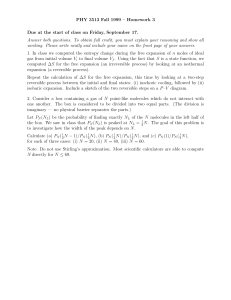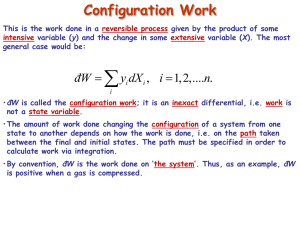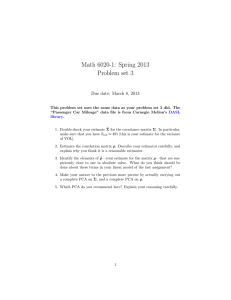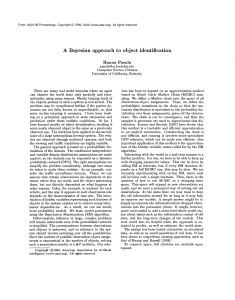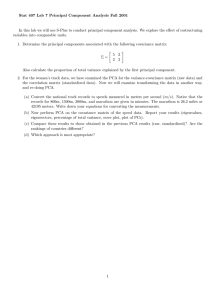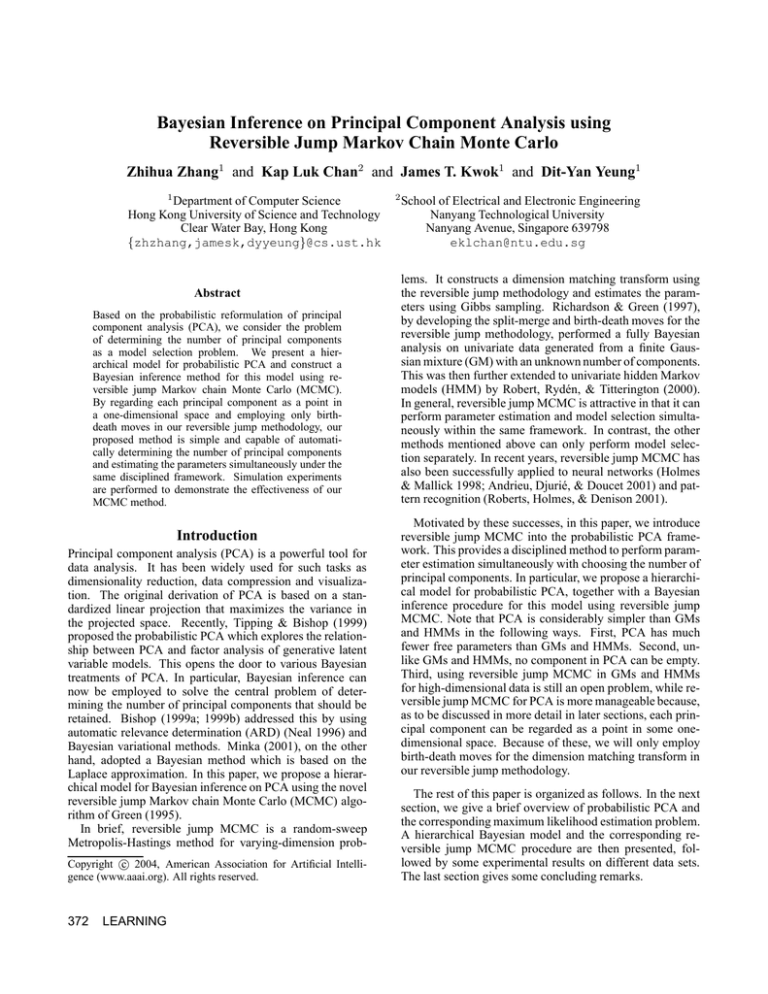
Bayesian Inference on Principal Component Analysis using
Reversible Jump Markov Chain Monte Carlo
Zhihua Zhang1 and Kap Luk Chan2 and James T. Kwok1 and Dit-Yan Yeung1
1
Department of Computer Science
Hong Kong University of Science and Technology
Clear Water Bay, Hong Kong
{zhzhang,jamesk,dyyeung}@cs.ust.hk
Abstract
Based on the probabilistic reformulation of principal
component analysis (PCA), we consider the problem
of determining the number of principal components
as a model selection problem. We present a hierarchical model for probabilistic PCA and construct a
Bayesian inference method for this model using reversible jump Markov chain Monte Carlo (MCMC).
By regarding each principal component as a point in
a one-dimensional space and employing only birthdeath moves in our reversible jump methodology, our
proposed method is simple and capable of automatically determining the number of principal components
and estimating the parameters simultaneously under the
same disciplined framework. Simulation experiments
are performed to demonstrate the effectiveness of our
MCMC method.
Introduction
Principal component analysis (PCA) is a powerful tool for
data analysis. It has been widely used for such tasks as
dimensionality reduction, data compression and visualization. The original derivation of PCA is based on a standardized linear projection that maximizes the variance in
the projected space. Recently, Tipping & Bishop (1999)
proposed the probabilistic PCA which explores the relationship between PCA and factor analysis of generative latent
variable models. This opens the door to various Bayesian
treatments of PCA. In particular, Bayesian inference can
now be employed to solve the central problem of determining the number of principal components that should be
retained. Bishop (1999a; 1999b) addressed this by using
automatic relevance determination (ARD) (Neal 1996) and
Bayesian variational methods. Minka (2001), on the other
hand, adopted a Bayesian method which is based on the
Laplace approximation. In this paper, we propose a hierarchical model for Bayesian inference on PCA using the novel
reversible jump Markov chain Monte Carlo (MCMC) algorithm of Green (1995).
In brief, reversible jump MCMC is a random-sweep
Metropolis-Hastings method for varying-dimension probc 2004, American Association for Artificial IntelliCopyright gence (www.aaai.org). All rights reserved.
372
LEARNING
2
School of Electrical and Electronic Engineering
Nanyang Technological University
Nanyang Avenue, Singapore 639798
eklchan@ntu.edu.sg
lems. It constructs a dimension matching transform using
the reversible jump methodology and estimates the parameters using Gibbs sampling. Richardson & Green (1997),
by developing the split-merge and birth-death moves for the
reversible jump methodology, performed a fully Bayesian
analysis on univariate data generated from a finite Gaussian mixture (GM) with an unknown number of components.
This was then further extended to univariate hidden Markov
models (HMM) by Robert, Rydén, & Titterington (2000).
In general, reversible jump MCMC is attractive in that it can
perform parameter estimation and model selection simultaneously within the same framework. In contrast, the other
methods mentioned above can only perform model selection separately. In recent years, reversible jump MCMC has
also been successfully applied to neural networks (Holmes
& Mallick 1998; Andrieu, Djurié, & Doucet 2001) and pattern recognition (Roberts, Holmes, & Denison 2001).
Motivated by these successes, in this paper, we introduce
reversible jump MCMC into the probabilistic PCA framework. This provides a disciplined method to perform parameter estimation simultaneously with choosing the number of
principal components. In particular, we propose a hierarchical model for probabilistic PCA, together with a Bayesian
inference procedure for this model using reversible jump
MCMC. Note that PCA is considerably simpler than GMs
and HMMs in the following ways. First, PCA has much
fewer free parameters than GMs and HMMs. Second, unlike GMs and HMMs, no component in PCA can be empty.
Third, using reversible jump MCMC in GMs and HMMs
for high-dimensional data is still an open problem, while reversible jump MCMC for PCA is more manageable because,
as to be discussed in more detail in later sections, each principal component can be regarded as a point in some onedimensional space. Because of these, we will only employ
birth-death moves for the dimension matching transform in
our reversible jump methodology.
The rest of this paper is organized as follows. In the next
section, we give a brief overview of probabilistic PCA and
the corresponding maximum likelihood estimation problem.
A hierarchical Bayesian model and the corresponding reversible jump MCMC procedure are then presented, followed by some experimental results on different data sets.
The last section gives some concluding remarks.
Probabilistic PCA
Probabilistic PCA was proposed by Tipping & Bishop
(1999). In this model, a high-dimensional random vector x
is expressed as a linear combination of basis vectors (hj ’s)
plus noise ():
q
X
x =
hj w j + m + respectively, where Uq is a d×q orthogonal matrix in which
the q column vectors are the principal eigenvectors of S,
Λq is a q × q diagonal matrix containing the corresponding
eigenvalues λ1 , . . . , λq , and R is an arbitrary q × q orthogb the maximum likelihood estimate
onal matrix. For H = H,
2
of σ is given by
σ
b2 =
j=1
= Hw + m + ,
∼ N (0, V),
(1)
(2)
where x ∈ Rd , w = (w1 , . . . , wq )T ∈ Rq , q < d, and
H = [h1 , . . . , hq ] is a d × q matrix that relates the two sets
of variables x and w. The vector m allows the model to
have non-zero mean. In PCA, the noise variance matrix V
is hyperspherical, i.e.,
V = σ 2 Id ,
(3)
and the latent variables w1 , . . . , wq are independent Gaussians with zero mean and unit variance, i.e.,
w ∼ N (0, Iq ).
Note that the probabilistic PCA is closely related to factor
analysis, with the only difference being that the noise variance matrix V in factor analysis is a general diagonal matrix.
Given an observed data set D = {x1 , . . . , xN }, the goal
of PCA is to estimate the matrix H in (1) and the noise variance σ 2 in (3). From (1) and (2), we can obtain the conditional probability of the observation vector x as
x|w, H, m, σ 2 ∼ N (Hw + m, σ 2 I),
and so, by integrating out w, we have
Z
2
p(x|H, m, σ ) = p(x|w, H, m, σ 2 )p(w)dw.
which implies that the maximum likelihood noise variance
is equal to the average of the left-out eigenvalues.
Bayesian Formalism for PCA
Hierarchical Model and Priors
In a fully Bayesian framework, both the number of principal components (q) and the model parameters (θ =
{H, m, σ 2 }) are considered to be drawn from appropriate
prior distributions. We assume that the joint density of all
these variables takes the form
p(q, θ, D) = p(q)p(θ |q) p(D |θ, q) .
H = Uq (Lq − σ 2 Iq )1/2 R,
where UTq Uq = Iq , RT R = Iq , and Lq = diag(l1 , . . . , lq ).
It is easy to extend the d × q matrix Uq to a d × d orthogonal
matrix U such that U = (Uq , Ud−q ) and UTd−q Ud−q =
Id−q . Letting
q
L=
d−q
x|H, m, σ 2 ∼ N (m, C),
we have
with C = HHT + σ 2 I. The corresponding likelihood is
therefore
ULUT
p(D|H, m, σ ) =
N
Y
p(xi |H, m, σ )
(5)
From (Tipping & Bishop 1999), the maximum likelihood
estimates of m and H are
b =
m
N
1 X
xi ,
N i=1
b = Uq (Λq − σ 2 Iq )1/2 R,
H
q
L q − σ 2 Iq
0
= (Uq , Ud−q )
d−q
0
,
0
Lq − σ 2 Iq
0
0
0
UTq
UTd−q
= HHT .
= (2π)−N d/2 |HHT + σ 2 I|−N/2
T
2 −1
N
×e− 2 tr((HH +σ I) S) ,
(4)
N
1 X
S=
(xi − m)(xi − m)T .
N i=1
= Uq (Lq − σ 2 I)UTq
2
i=1
where
(7)
Following (Minka 2001), we decompose the matrix H as
Note that (Tipping & Bishop 1999)
2
d
X
1
λj ,
d − q j=q+1
(6)
Hence,
HHT + σ 2 Id
= ULUT + σ 2 Id
Lq
0
= U
UT .
0 σ 2 Id−q
(8)
Since the matrix S in (5) is symmetric and positive definite,
we can decompose it as S = AGAT , where A is an orthogonal matrix consisting of the eigenvectors of S, and G
is diagonal with diagonal elements gi ’s being the eigenvalues of S.
For simplicity, we set R = Iq and use the maximum likelihood estimators for m and U. In other words, we obtain
m from (6) and set U to be the eigenvector matrix A of S.
LEARNING 373
Combining with (4) and (8), we can rewrite the likelihood
as:
α
η
p(D|l1−1 , . . . , lq−1 , σ −2 )
=
N
Y
λ
p(xi |l1−1 , . . . , lq−1 , σ −2 )
i=1
= (2π)−
×e
Nd
2
−2
− N σ2
q
Y
j=1
Pd
−N/2 −N (d−q)
lj
j=q+1
σ
gj
N
× e− 2
Pq
−1
j=1 lj gj
σ2
.
Now, our goal is to estimate the parameters (lj ’s and σ 2 )
and the number of principal components (q) via reversible
jump MCMC. First of all, we have to choose a proper prior
distribution for each parameter. A common choice for q is
the Poisson distribution with hyperparameter λ. Here, for
convenience of presentation and interpretation, we assume
that q follows a uniform prior on {1, 2, · · · , d − 1}.
To ensure identifiability, we impose the following ordering constraint on lj ’s and σ 2 :
l1 > l 2 > · · · > l q > σ 2 .
The prior joint density for these parameters is then given by:
p(l1 , . . . , lq , σ 2 |q) = (q + 1)! p(l1 , . . . , lq , σ 2 )
×Il1 >l2 >···>lq >σ2 (l, σ 2 ),
where I denotes the indicator function, and the (q + 1)! term
arises from the ordering constraint.
We assume that l1 , . . . , lq and σ 2 are distributed a priori
as independent variables conditioned on some hyperparameter. In this case, we consider the prior distributions for the
parameters l1 , . . . , lq and σ 2 as conjugate priors:
lj−1
∼ Γ(r, τ ),
−2
∼ Γ(r, τ ),
σ
j = 1, 2, . . . , q,
where Γ(·, ·) denotes the Gamma distribution.1 Since the
hyperparameter r > 0 represents the shape of the Gamma
distribution, it is appropriate to pre-specify it. In this paper,
r is held fixed while τ > 0 is also given a Gamma prior:
τ ∼ Γ(α, η),
where α > 0 and η > 0. We have thus obtained a complete hierarchical model (Figure 1), which can be represented graphically in the form of a directed acyclic graph
(DAG).
Reversible Jump MCMC Methodology
For the hierarchical model proposed above, the goal of
Bayesian inference is to generate realizations from the conditional joint density p (q, θ|D) derived from (7). The reversible jump MCMC algorithm in (Green 1995) allows
1
The Gamma density of a random variable x ∼ Γ(α, λ) is defined as:
λα α−1 −λx
x
e
,
p(x; α, λ) =
Γ(α)
where α > 0, λ > 0 are the shape and scaling parameters, respectively.
374
LEARNING
Figure 1: DAG for the proposed probabilistic PCA model.
us to handle this problem even when the number of principal components is unknown. The algorithm proceeds
by augmenting the usual proposal step of a random-sweep
Metropolis-Hastings method with variable dimensions. It
constructs the dimension matching transform with the splitmerge or birth-death moves by adding or removing a latent
variable. As discussed in the introduction section, we only
use the birth-death moves in this paper. Consequently, each
sweep of our reversible jump MCMC procedure consists of
three types of moves:
(a) update the parameters lj ’s and σ;
(b) update the hyperparameter τ ;
(c) the birth or death of a component.
Move types (a) and (b) are used for parameter estimation via Gibbs sampling. Since move type (c) involves
changing the number of components q by 1, it constitutes
the reversible jump and is used for model selection via the
Metropolis-Hastings algorithm. Assume that a move of type
m, which moves from the current state s to a new state s0
in a higher-dimensional space, is proposed. This is often
implemented by drawing a vector v of continuous random
variables, independent of s, and denoting s0 by using an invertible deterministic function f (s, v). Then, the acceptance
probabilities from s to s0 and from s0 to s are min(1, R) and
min(1, R−1 ), respectively, where
p (s0 |x) rm (s0 )
R=
p (s|x) rm (s)p(v)
∂s0 ∂(s, v) ,
(9)
rm (s) is the probability of choosing move
type
m in state
∂s0 s, p(v) is the density function of v, and ∂(s,v) is the Jacobian arising from the change of variables from (s, v) to
s0 . Using (9) for our probabilistic PCA model, the acceptance probability for the birth move from {q, l1−1 , . . . , lq−1 }
−1
to {q + 1, l1−1 , . . . , lq−1 , lq+1
} is min(1, R), where
R
= (likelihood ratio)
p(q + 1)
(q + 2)
p(q)
−1
p(l1−1 , . . . , lq+1
, σ −2 )
×
p(l1−1 , . . . , lq−1 , σ −2 )
dq+1
1
−1 . (10)
bq p(lq+1
)
Here, dk and bk are the probabilities of attempting death and
birth moves, respectively, when the current state has k latent
variables. Usually, bj = dj = 0.5 when j = 2, . . . , d − 2,
d1 = bd−1 = 0 and b1 = dd−1 = 1. Our death proposal
proceeds by choosing the latent variable with the smallest
eigenvalue.
The correspondence between (9) and (10) is fairly
straightforward. The first two terms of (10) form the ratio
p(s0 |x)
(q+2)!
p(s|x) , the (q + 2)-factor is the ratio (q+1)! from the order
statistics densities for the parameters lj ’s and σ 2 , and the last
(s0 )
term is the proposal ratio rmrm
(s)p(v) . The Jacobian is equal
to unity because we are drawing new principal components
independent of the current parameters.
Reversible Jump MCMC Algorithm for
Probabilistic PCA
We use Gibbs sampling (Gilks, Richardson, & Spiegelhalter 1996) to simulate the parameters and hyperparameters in
our model. The reversible jump MCMC algorithm for the
proposed probabilistic PCA method is described as follows:
Reversible Jump MCMC Algorithm
1. Initialization: Sample (q, σ −2 , l1−1 , . . . , lq−1 , τ ) from their
priors.
2. Iteration t:
• Update the parameters and hyperparameters using
Gibbs sampling.
• Draw a uniform random variable u ∼ U(0, 1);
• If u ≤ bq , then perform the Birth move.
• Else if u ≤ bq + dq , then perform the Death move.
• End if
3. Set t = t + 1 and go back to Step 2 until convergence.
Gibbs Sampler
1. For j = 1, · · · , q, simulate from the full conditionals
N
N gj
(lj ),
+ r,
+ τ I
lj−1 | · · · ∼ Γ
lj−1 ,lj+1
2
2
Pd
N (d − q)
N j=q+1 gj
−2
σ |··· ∼ Γ
+ r,
+τ
2
2
(σ 2 ).
×I
0,lq
2. Simulate the hyperparameter τ from its full conditional:
q
X
τ | · · · ∼ Γ (q + 1)r + α,
lj−1 + σ −2 + η .
j=1
Birth move
−1
1. Draw lq+1
from its prior Γ(r, τ )I [lq ,σ2 ] (lq+1 ).
2. Calculate the acceptance probability α = min(1, R) of
the birth move using (10).
3. Draw a uniform random variable v ∼ U(0, 1).
4. If v < α, then accept the proposed state; otherwise, set
the next state to be the current state.
Death move
1. Remove the qth principal component.
2. Calculate the acceptance probability α = min(1, R −1 ) of
the death move using (10).
3. Draw a uniform random variable v ∼ U(0, 1).
4. If v < α, then accept the proposed state; otherwise, set
the next state to be the current state.
Experiments
In this section, we perform experiments on several data sets
to demonstrate the efficacy of the reversible jump MCMC
algorithm for probabilistic PCA. We adopt the recommendation of Richardson & Green (1997) on the choice of hyperparameters and set r > 1 > α. Also, we set r = 3.0,
α = 0.5, and η = 1.2/V , where V is the standard deviation
of the data. We run our algorithm for 20,000 sweeps in the
following two experiments. The first 10,000 sweeps are discarded as burn-in. All our inferences are based on the last
10,000 sweeps.
Experiment 1
In the first experiment, we generate a data set (Set 1) of
1,000 points from a 6-dimensional Gaussian distribution,
with variances in the 6 dimensions equal to 10, 7, 5, 3, 1
and 1, respectively. The eigenvalues of the observed covariance matrix on the data so generated are 8.9580, 7.2862,
5.3011, 2.8964, 1.1012 and 0.9876, respectively. Table 1
shows the posterior probabilities for different numbers of
principal components (q) and the corresponding estimated
values of the parameters (lj ’s and σ 2 ). As we can see, the
posterior probability of q is tightly concentrated at q = 4,
which agrees with our intuition that there are 4 dominant dimensions in this data set. Moreover, the estimated values of
the parameters are very close to the true ones. Figure 2 depicts the jumping in the number of principal components on
the last 10,000 sweeps.
Table 1: Posterior probabilities for different numbers of
principal components (q’s) and the estimated values of lj ’s
and σ 2 .
q p(q|D)
σ2
lj ’s
9.0342, 7.3198
4 0.8666 1.0573
5.2214, 2.9420
9.0322, 7.3187
5 0.1334 1.0263 5.2201, 2.9403, 1.0930
LEARNING 375
Like the variational method in (Bishop 1999b), our proposed MCMC method does not provide one specific value
on the number of principal components that should be retained. Instead, it provides posterior probability estimate for
each possible dimensionality over the complete range. This
leaves room for us to make an appropriate decision. In many
applications, however, these probabilities are tightly concentrated at a specific dimensionality or only a few dimensionalities that are close to each other. Notice that the number
of principal components q only jumps between 4 and 5 after the burn-in period. Since the noise variance σ 2 is very
close to the variance of either of the last two principal components (Table 1), either one may be treated as a noise term
and hence q is sometimes estimated to be equal to 5.
1997) are developed for the empty components, which is
only a supplement of the split-merge moves in order to enhance the robustness of the reversible jump method. Apparently, it is possible to use split-merge moves instead of birthdeath moves to develop a reversible jump method for PCA.
Recently, Stephens (2000) used the birth-death process instead of the reversible jump methodology and described an
alternative of the reversible jump MCMC, called the birthdeath MCMC. This birth-death MCMC differs from our
method in that ours still follows the setting of standard reversible jump MCMC. Moreover, the computational cost of
the birth-death MCMC is far higher than that of reversible
jump MCMC. The relationship between these two has also
been recently studied in (Cappé, Robert, & Rydén 2003).
Appendix
Experiment 2
In the second experiment, we use three data sets similar
to those used by Minka (2001). The first data set (Set 2
in Table 2) consists of 100 points generated from a 10dimensional Gaussian distribution, with variances in the first
5 dimensions equal to 10, 8, 6, 4 and 2 respectively, and with
variance equal to 1 in the last 5 dimensions. The second data
set (Set 3 in Table 2) consists of 100 points generated from a
10-dimensional Gaussian distribution, with variances in the
first 5 dimensions equal to 10, 8, 6, 4 and 2 respectively,
and with variance 0.1 in the last 5 dimensions. The third
data sets (Set 4 in Table 2), consisting of 10,000 points, is
generated from a 15-dimensional Gaussian distribution, with
variances in the first 5 dimensions equal to 10, 8, 6, 4 and
2 respectively, and with variance equal to 0.1 in the last 10
dimensions.
Table 2 shows the posterior probabilities for different
numbers of principal components (q) and Figure 2 depicts
the jumping in the number of principal components during
the last 10,000 sweeps. As we can see, the posterior probabilities are all tightly concentrated at q = 5, which agrees
with our intuition that there are 5 dominant dimensions in
these data sets.
We assume independence between D = {x1 , . . . , xN }
given all model parameters, and between l1−1 , . . . , lq−1 and
σ −2 given the hyperparameter τ . For convenience, we denote l−1 = {l1−1 , . . . , lq−1 } and θ ={l−1 , τ , σ −2 }. The joint
distribution of the data and parameters is:
N
nY
o
p(D, θ) =
p(xi |l−1 , σ −2 )
i=1
×
j=1
= (2π)−
376
LEARNING
o
p(lj−1 |τ ) × p(σ −2 |τ )p(τ )
Nd
2
q
Y
−N
2
lj
σ −N (d−q)
j=1
Pq
−1
−2 Pd
j=q+1 gj
j=1 lj gj +σ
×e
q
o
nY
p(lj−1 |τ ) × p(σ −2 |τ )p(τ ).
×
−N
2
j=1
Then, the full conditionals for lj−1 , σ −2 and τ are
−1
−N
−N
2
2 lj g j
lj−1 | · · · ∼ lj
e
p(lj−1 |τ )
N
N gj
+ r,
+τ ,
∼ Γ
2
2
Concluding Remarks
In this paper, we have proposed a Bayesian inference
method for PCA using reversible jump MCMC. This allows simultaneous determination of the number of principal
components and estimation of the corresponding parameters. Moreover, since each principal component in this PCA
framework is considered as a point in a one-dimensional
space, the use of reversible jump MCMC becomes feasible.
Also, as the proposed probabilistic PCA framework is only
one of the possible generative latent variable models, in the
future, it is worthy to explore the reversible jump MCMC
methodology for other generative models, such as the mixture of probabilistic PCA, factor analysis and its mixture,
and independent component analysis.
In our reversible jump method, the dimension matching
transform only employs birth-death moves, but not both
split-merge and birth-death moves as in the reversible jump
method for Gaussian mixtures (Richardson & Green 1997).
Note that the birth-death moves of (Richardson & Green
q
nY
N σ−2
Pd
j=q+1 gj p(σ −2 |τ )
σ −2 | · · · ∼ σ −N (d−q) e− 2
Pd
N (d − q)
N j=q+1 gj
∼ Γ
+ r,
+τ ,
2
2
q
o
nY
p(lj−1 |τ ) × p(σ −2 |τ )p(τ )
τ| · · · ∼
j=1
∼ Γ (q + 1)r + α,
q
X
j=1
lj−1 + σ −2 + η ,
respectively.
References
Andrieu, C.; Djurié, P. M.; and Doucet, A. 2001. Model selection by MCMC computation. Signal Processing 81:19–
37.
Table 2: Posterior probabilities for different numbers of principal components (q’s).
Number
of points
100
100
10000
Data set
Set 2
Set 3
Set 4
Dimensionality
10
10
15
pi ≡ p(q = i|D)
p4 = 0.0231, p5 = 0.6830, p6 = 0.2329, p7 = 0.0566, p8 = 0.0043, p9 = 0.0001
p5 = 0.8907, p6 = 0.1023, p7 = 0.0070
p5 = 0.6346, p6 = 0.2681, p7 = 0.0436, p8 = 0.0532, p8 = 0.0005
7
9
8
6
7
5
6
4
5
3
0
1000
2000
3000
4000
5000
6000
7000
8000
9000
4
10000
0
1000
2000
3000
4000
(a) Set 1
5000
6000
7000
8000
9000
10000
6000
7000
8000
9000
10000
(b) Set 2
8
9
8
7
7
6
6
5
5
4
0
1000
2000
3000
4000
5000
6000
7000
8000
9000
10000
(c) Set 3
4
0
1000
2000
3000
4000
5000
(d) Set 4
Figure 2: Number of components vs. number of sweeps after the burn-in period of 10,000 sweeps.
Bishop, C. M. 1999a. Bayesian PCA. In Advances in Neural Information Processing Systems 11, volume 11, 382–
388.
Bishop, C. M. 1999b. Variational principal components. In
Proceedings of the International Conference on Artificial
Neural Networks, volume 1, 509–514.
Cappé, O.; Robert, C. P.; and Rydén, T. 2003. Reversible
jump, birth-and-death and more general continuous time
Markov chain Monte Carlo samplers. Journal of the Royal
Statistical Society, B 65:679–700.
Gilks, W. R.; Richardson, S.; and Spiegelhalter, D. J. 1996.
Markov Chain Monte Carlo in Practice. London: Chapman and Hall.
Green, P. J. 1995. Reversible jump Markov chain
Monte Carlo computation and Bayesian model determination. Biometrika 82:711–732.
Holmes, C. C., and Mallick, B. K. 1998. Bayesian radial
basis functions of variable dimension. Neural Computation
10:1217–1233.
Minka, T. P. 2001. Automatic choice of dimensionality
for PCA. In Advances in Neural Information Processing
Systems 13.
Neal, R. M. 1996. Bayesian Learning for Neural Networks.
New York: Springer-Verlag.
Richardson, S., and Green, P. J. 1997. On Bayesian analysis of mixtures with an unknown number of components
(with discussion). Journal of the Royal Statistical Society
Series B 59:731–792.
Robert, C. P.; Rydén, T.; and Titterington, D. M. 2000.
Bayesian inference in hidden Markov models through the
reversible jump Markov chain Monte Carlo method. Journal of the Royal Statistical Society Series B 62:57–75.
Roberts, S. J.; Holmes, C.; and Denison, D. 2001.
Minimum entropy data partitioning using reversible jump
Markov chain Monte Carlo. IEEE Transactions on Pattern
Analysis and Machine Intelligence 23(8):909–915.
Stephens, M. 2000. Bayesian analysis of mixtures with
an unknown number of components — an alternative to
reversible jump methods. Annals of Statistics 28:40–74.
Tipping, M. E., and Bishop, C. M. 1999. Probabilistic principal component analysis. Journal of the Royal Statistical
Society, Series B 61(3):611–622.
LEARNING 377



